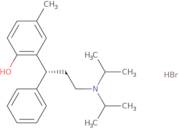
TolterodineHydrobromide
CAS: 837376-36-0
Ref. 3D-FT148292
| 25mg | Nachfragen | ||
| 50mg | Nachfragen | ||
| 100mg | Nachfragen | ||
| 250mg | Nachfragen | ||
| 500mg | Nachfragen |
Produktinformation
- 2-[3-(Diisopropylamino)-1-phenylpropyl]-4-methylphenol hydrobromide
- 2-[3-[Bis(1-Methylethyl)Amino]-1-Phenylpropyl]-4-Methylphenol Hydrobromide
- 2-{(1R)-3-[bis(1-methylethyl)amino]-1-phenylpropyl}-4-methylphenol hydrobromide
- N,N-Diisopropyl-3-(2-hydroxy-5-Methylphenyl)-3-Phenylpropylamine HBr
- N,N-Diisopropyl-3-(2-hydroxy-5-methylphenyl)-3-phenylpropanamine hydrobromide
- N,N-Diisopropyl-3-(2-hydroxy-5-methylphenyl)-3-phenylpropylamine hydrobromide
- Phenol, 2-[3-[bis(1-methylethyl)amino]-1-phenylpropyl]-4-methyl-, hydrobromide
- Phenol, 2-[3-[bis(1-methylethyl)amino]-1-phenylpropyl]-4-methyl-, hydrobromide (1:1)
- Racemic tolterodine hydrobromide
Tolterodine is a prodrug that is converted to its active form, tolterodine tartrate, by sulfonation of the diisopropylamine moiety. Tolterodine has a high affinity for the ileal and vesical muscarinic receptors and is used in the treatment of overactive bladder and urinary incontinence. The conversion of tolterodine to its active form can be inhibited by markers such as erythromycin, ketoconazole, or itraconazole. Tolterodine also has enantiomeric forms (d-tolterodine and l-tolterodine). The presence of d-tolterodine was shown to be associated with increased efficacy in patients with overactive bladder symptoms who have been treated with this drug.
Chemische Eigenschaften
Technische Anfrage zu: 3D-FT148292 TolterodineHydrobromide
Wenn Sie ein Angebot anfordern oder eine Bestellung aufgeben möchten, legen Sie stattdessen die gewünschten Produkte in Ihren Warenkorb und fordern Sie dann ein Angebot oder eine Bestellung an aus dem Warenkorb. Es ist schneller, billiger und Sie können von den verfügbaren Rabatten und anderen Vorteilen profitieren.





